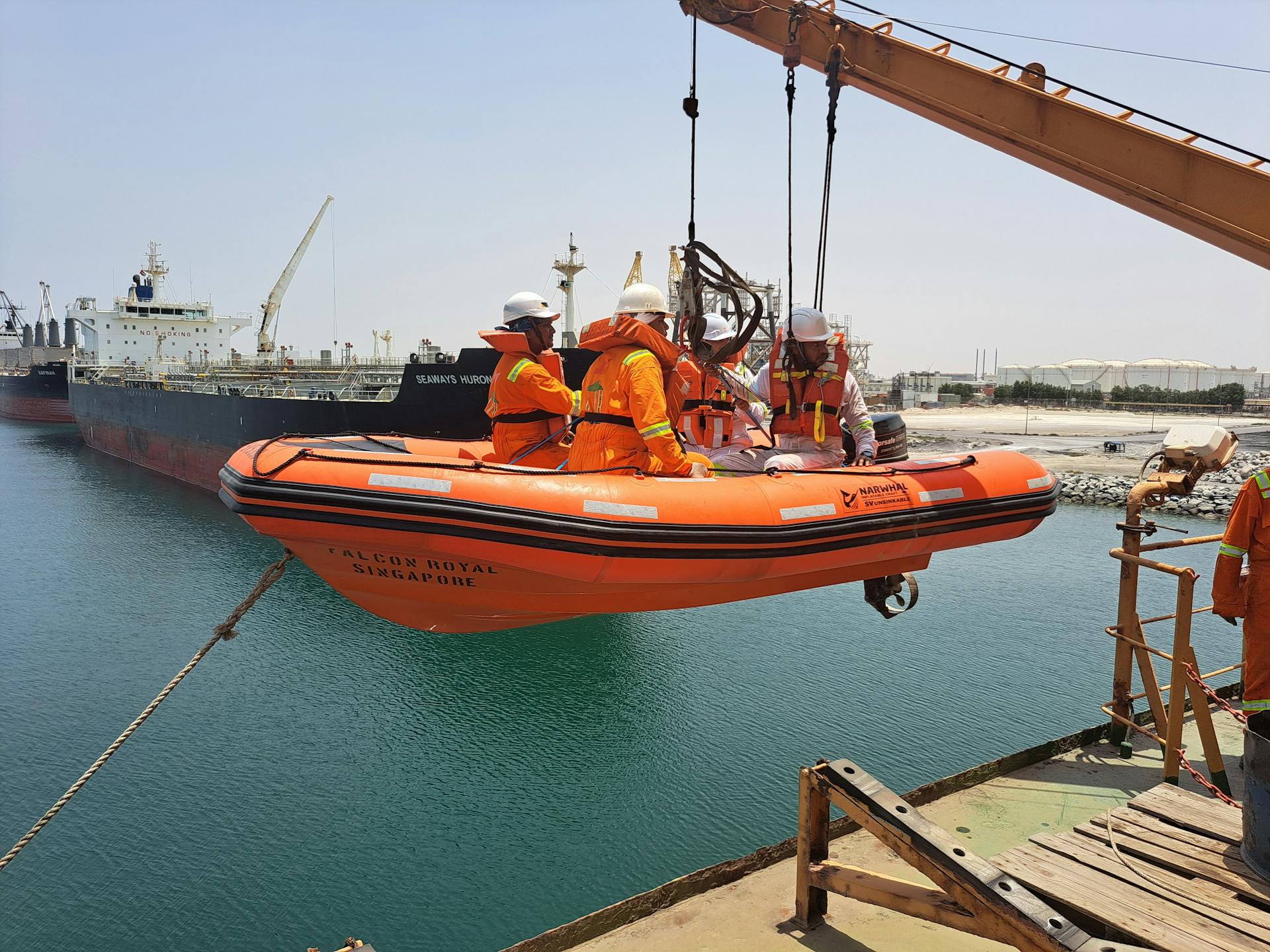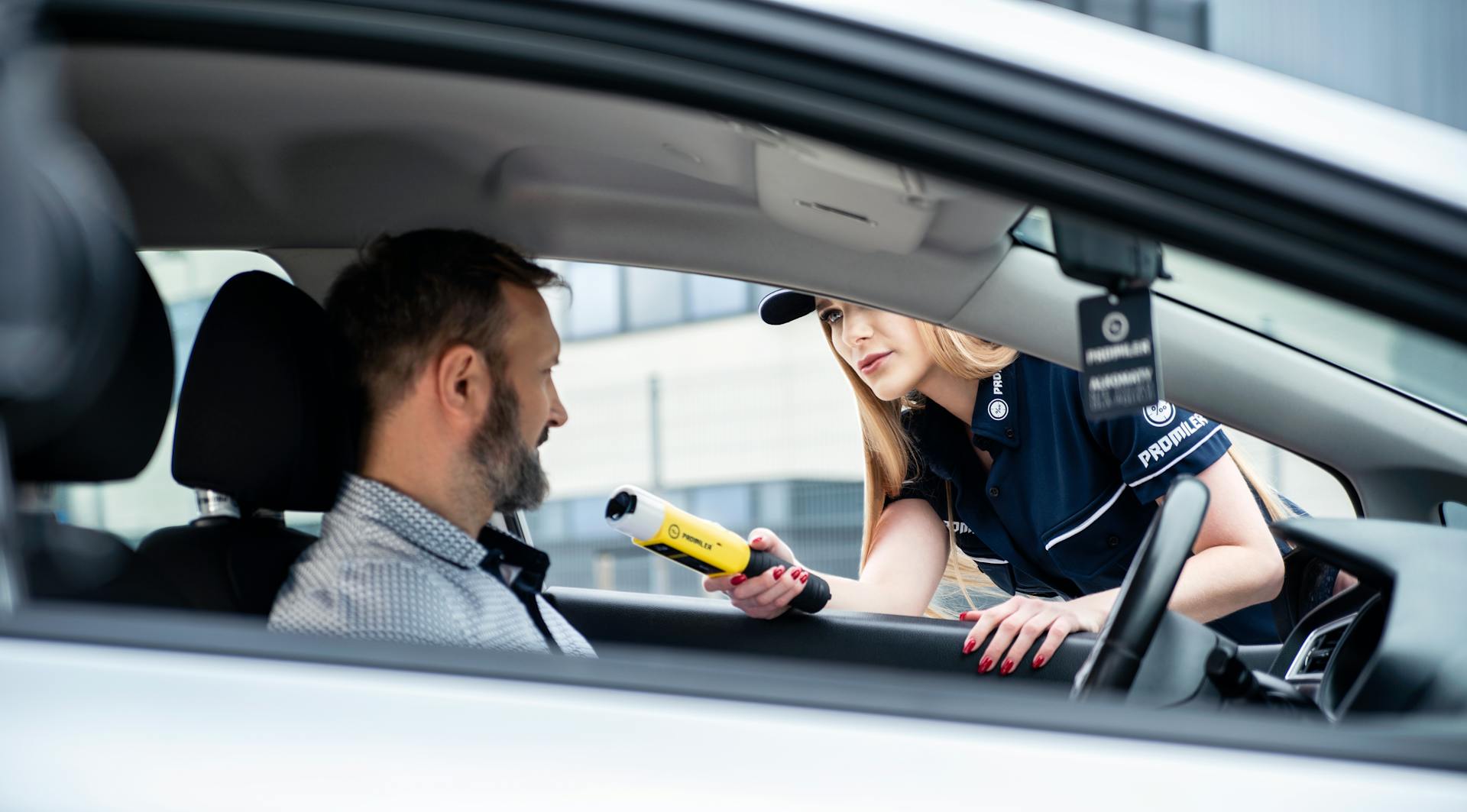
The Port Marine Safety Code is a set of guidelines designed to minimize risks and ensure safe operations in ports. It's a crucial framework for port authorities, operators, and users to follow.
The code provides a structured approach to managing risks, with a focus on identifying and mitigating potential hazards. This includes assessing the risks associated with different types of vessels, cargo, and operations.
Port authorities have a critical role to play in enforcing the code and ensuring compliance. They must establish and maintain a risk management system, which includes regular audits and inspections.
The code also emphasizes the importance of training and education for all personnel involved in port operations. This includes training on safety procedures, emergency response, and equipment operation.
Duty Holder Responsibilities
As a duty holder, you play a crucial role in ensuring your organisation complies with the Port Marine Safety Code.
To effectively undertake this role, you should be aware of your organisation's powers and duties related to marine safety.
Discover more: European Sea Ports Organisation

You'll also need to ensure that a suitable MSMS (Marine Safety Management System) is in place, which employs formal safety assessment techniques.
A designated person should be appointed to monitor and report the effectiveness of the MSMS and provide independent advice on marine safety matters.
Competent people should be appointed to manage marine safety, and the management of marine safety should continuously improve.
This can be achieved by publishing a marine safety plan and reporting performance against the objectives and targets set.
You'll need to report compliance with the Code to the Maritime and Coastguard Agency every three years.
Here's a summary of your key responsibilities:
- Be aware of organisation's powers and duties related to marine safety
- Ensure a suitable MSMS is in place
- Appoint a designated person for marine safety
- Appoint competent people to manage marine safety
- Continuously improve marine safety management
- Report compliance with the Code every 3 years
Marine Safety Code
The Port Marine Safety Code is a national standard in the UK that aims to improve safety for those who use or work in ports, their ships, passengers, and cargoes, and the environment.
The code is based on five general principles, which are accountability, formal assessment of hazards and risks, safety management systems, competence standards, and good practice.
One of the key principles of the code is that harbour authorities should have formal safety management systems in place to ensure that all risks are tolerable and as low as reasonably practicable.
If this caught your attention, see: Marine Fuel Management
Code Overview

The Port Marine Safety Code (PMSC) is a national standard for port safety in the UK, with the aim of improving safety for those who use or work in ports, their ships, passengers, and cargoes, and the environment.
The code is based on five general principles that harbour authorities should follow. These principles are:
- The harbour authority are accountable for their duties and powers and should measure themselves against nationally agreed standards.
- Powers, policies, and procedures should be based on formal assessment of hazards and risks, and harbour authorities should have formal safety management systems.
- The aim of a safety management system is to ensure that all risks are tolerable and as low as reasonably practicable.
- Safety management systems depend upon competence standards applied to all parties involved - these have been developed in parallel to the code.
- Harbour Authorities should monitor and adopt good practice.
The code requires harbour authorities to formally identify and designate who is accountable for compliance with the code and ensuring marine safety.
Key Components
The Marine Safety Code is made up of several key components that work together to ensure the safety of vessels and their crews.
The International Convention for the Safety of Life at Sea (SOLAS) is a major component of the Marine Safety Code, established in 1914 to prevent loss of life at sea.
The SOLAS Convention requires vessels to carry safety equipment and follow safety protocols to minimize the risk of accidents.
These protocols include regular drills and training exercises for crew members.
Check this out: Sea Ports in Japan
The use of safety equipment such as life rafts, emergency position-indicating radio beacons (EPIRBs), and fire extinguishers is also mandated by SOLAS.
The International Load Line Convention is another important component of the Marine Safety Code, establishing rules for the safe loading and stowage of cargo.
The Load Line Convention requires vessels to have a load line marked on the hull to indicate the maximum allowed draft.
The Load Line Convention also sets standards for the size and type of cargo that can be carried on a vessel.
The Marine Safety Code is overseen by the International Maritime Organization (IMO), which sets global standards for maritime safety.
The IMO works with governments and industry stakeholders to develop and implement safety regulations.
Recommended read: P&O Stena Line
General Responsibilities
As a port authority, it's essential to understand the general responsibilities that come with implementing a Port Marine Safety Code. The duty holder is responsible for ensuring their organisation complies with the Code.
To effectively undertake this role, the duty holder should be aware of their organisation's powers and duties related to marine safety. This knowledge will help them make informed decisions and take necessary actions to maintain a safe harbour environment.
A suitable Marine Safety Management System (MSMS) should be in place, which employs formal safety assessment techniques. This system will help identify potential risks and hazards, and provide a framework for mitigating them.
The duty holder should appoint a suitable designated person to monitor and report the effectiveness of the MSMS. This person should provide independent advice on matters of marine safety, ensuring that the duty holder is making informed decisions.
In addition to the designated person, the duty holder should appoint competent people to manage marine safety. These individuals should have the necessary skills and expertise to identify and address potential safety risks.
The duty holder should also ensure that the management of marine safety continuously improves by publishing a marine safety plan and reporting performance against the objectives and targets set. This will help identify areas for improvement and ensure that the harbour remains a safe place for all users.
Recommended read: Port Place Nanaimo Bc
To provide additional accountability, the duty holder should formally identify and designate who is accountable for compliance with the code and ensuring marine safety. This can be done by delegating accountability to a specific individual or group, such as the Harbour Master.
Here is a summary of the key responsibilities of the duty holder:
- Be aware of the organisation’s powers and duties related to marine safety
- Ensure a suitable MSMS is in place
- Appoint a suitable designated person
- Appoint competent people to manage marine safety
- Ensure continuous improvement of marine safety management
- Report compliance with the Code to the Maritime and Coastguard Agency every 3 years
Sources
- https://www.gov.uk/government/publications/port-marine-safety-code-compliant-ports
- https://www.broads-authority.gov.uk/boating/navigating-the-broads/safety/port-marine-safety-code
- https://harbours.gg/article/199255/Port-Marine-Safety-Code
- https://portsmouth-port.co.uk/at-the-port/port-marine-safety-code/
- https://www.ports.je/jerseyharbours/commercial/portmarinesafetycode/
Featured Images: pexels.com


